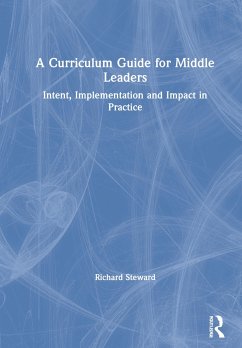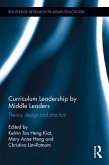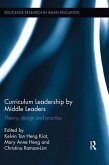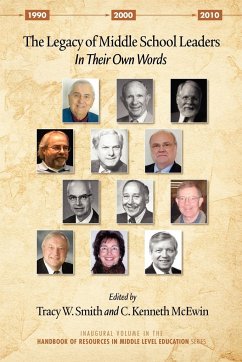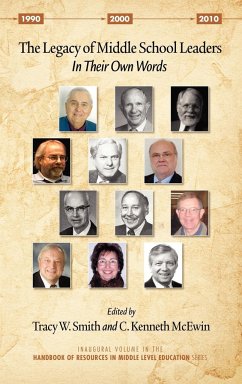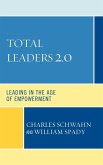- Broschiertes Buch
- Merkliste
- Auf die Merkliste
- Bewerten Bewerten
- Teilen
- Produkt teilen
- Produkterinnerung
- Produkterinnerung
A Curriculum Guide to Middle leadership is a comprehensive guide to the curriculum for middle leaders and subject leaders. Designed to support middle leaders in both primary and secondary schools, it explores every aspect of successful curriculum leadership beginning with Intent and moving on to cover Implementation and Impact.
Andere Kunden interessierten sich auch für
![Curriculum Leadership by Middle Leaders Curriculum Leadership by Middle Leaders]() Curriculum Leadership by Middle Leaders228,99 €
Curriculum Leadership by Middle Leaders228,99 €![Curriculum Leadership by Middle Leaders Curriculum Leadership by Middle Leaders]() Curriculum Leadership by Middle Leaders65,99 €
Curriculum Leadership by Middle Leaders65,99 €![The Legacy of Middle School Leaders The Legacy of Middle School Leaders]() The Legacy of Middle School Leaders84,99 €
The Legacy of Middle School Leaders84,99 €![The Legacy of Middle School Leaders The Legacy of Middle School Leaders]() The Legacy of Middle School Leaders118,99 €
The Legacy of Middle School Leaders118,99 €![Creating a Culture of Support for Teacher Leaders Creating a Culture of Support for Teacher Leaders]() Creating a Culture of Support for Teacher Leaders71,99 €
Creating a Culture of Support for Teacher Leaders71,99 €![Creating a Culture of Support for Teacher Leaders Creating a Culture of Support for Teacher Leaders]() Creating a Culture of Support for Teacher Leaders39,99 €
Creating a Culture of Support for Teacher Leaders39,99 €![Total Leaders 2.0 Total Leaders 2.0]() Charles J. SchwahnTotal Leaders 2.0130,99 €
Charles J. SchwahnTotal Leaders 2.0130,99 €-
-
-
A Curriculum Guide to Middle leadership is a comprehensive guide to the curriculum for middle leaders and subject leaders. Designed to support middle leaders in both primary and secondary schools, it explores every aspect of successful curriculum leadership beginning with Intent and moving on to cover Implementation and Impact.
Hinweis: Dieser Artikel kann nur an eine deutsche Lieferadresse ausgeliefert werden.
Hinweis: Dieser Artikel kann nur an eine deutsche Lieferadresse ausgeliefert werden.
Produktdetails
- Produktdetails
- Verlag: Routledge
- Seitenzahl: 210
- Erscheinungstermin: 30. Dezember 2020
- Englisch
- Abmessung: 246mm x 174mm x 12mm
- Gewicht: 384g
- ISBN-13: 9780367610968
- ISBN-10: 0367610965
- Artikelnr.: 60606029
- Herstellerkennzeichnung
- Libri GmbH
- Europaallee 1
- 36244 Bad Hersfeld
- gpsr@libri.de
- Verlag: Routledge
- Seitenzahl: 210
- Erscheinungstermin: 30. Dezember 2020
- Englisch
- Abmessung: 246mm x 174mm x 12mm
- Gewicht: 384g
- ISBN-13: 9780367610968
- ISBN-10: 0367610965
- Artikelnr.: 60606029
- Herstellerkennzeichnung
- Libri GmbH
- Europaallee 1
- 36244 Bad Hersfeld
- gpsr@libri.de
Richard Steward is an educational consultant with extensive experience as a teacher and headteacher. He has taught in a variety of schools in a thirty-year career and has worked as a part-time lecturer with The Open University. He has worked with the National College for Teaching and Learning and been involved in a wide range of national educational research projects. His previous books include The Gradual Art of School Improvement and The Toxic Classroom.
Introduction
PART 1 INTENT
1 What is meant by 'intent'?
2 Do I have a vision for my subject?
3 How do I work within the context of the whole school and address whole
school priorities?
4 What do I want pupils to be able to do by the end
of the year?
5 How do I identify areas for improvement?
6 How do I write a curriculum statement?
7 How do I create a curriculum plan?
8 How do I make my curriculum plans visible?
9 How do I choose what to teach?
10 What is meant by sequencing?
11 What is interleaving?
12 How do I plan for progression?
13 How important is transition to my planning?
14 How do I meet the needs of SEND and disadvantaged pupils?
15 What about differentiation?
16 From intent to implementation.
PART 2 IMPLEMENTATION
17 What is meant by implementation?
18 How important is subject knowledge?
19 Are knowledge organisers the answer?
20 How should pupils be assessed?
21 How do I fill gaps in pupils' learning?
22 How do I close the gap?
23 What is really meant by 'challenge'?
24 What does good teaching look like in a lesson?
25 How do I monitor the quality of teaching?
26 What do I do if my department is underperforming?
27 Why is consistency so important?
28 Should I insist on detailed lesson plans, and what about objectives?
29 How important are seating plans?
30 How important is questioning?
31 What should I look for in pupils' books?
32 What does good feedback look like?
33 How important is pupil voice?
34 I am not the head of English, so how important is literacy to me?
35 I am a subject leader; should I be responsible for behaviour?
36 How do I plan effective CPD?
37 Are visits to other schools an appropriate use of my time?
38 What do I do when I am not happy with changes to the curriculum?
39 Do I need timetabling skills to understand curriculum implementation?
40 Am I a leader or a manager?
41 How do I plan for public examinations?
42 How important is cross-curricular work?
43 What about pastoral leadership?
44 How do I lead in uncertain times?
PART 3 IMPACT
45 What is meant by impact?
46 How do I measure pupil performance?
47 How do I analyse data and pupil outcomes?
48 How do I ensure accurate predictions and assessments?
49 How do I measure impact in the classroom?
50 How do I evaluate impact on pupil groups - especially SEND and
disadvantaged pupils?
51 How do I provide evidence of impact for inspectors?
52 How do I handle the annual review with SLT and/or governors?
53 Finally, how do I know if I am doing a good job?
APPENDICES
A. Example curriculum statement: primary reading
B. Example curriculum statement: secondary English
C. Example curriculum plan: Y6 Maths
D. Example curriculum plan: Y7 Maths
E. Guidance: marking and feedback
F. Guidance: knowledge organisers
G. Guidance: department self-evaluation
H. Guidance: line management
I. Guidance: how to prepare for a deep dive
J. Guidance: deep dive questions
K. Guidance: work scrutiny
PART 1 INTENT
1 What is meant by 'intent'?
2 Do I have a vision for my subject?
3 How do I work within the context of the whole school and address whole
school priorities?
4 What do I want pupils to be able to do by the end
of the year?
5 How do I identify areas for improvement?
6 How do I write a curriculum statement?
7 How do I create a curriculum plan?
8 How do I make my curriculum plans visible?
9 How do I choose what to teach?
10 What is meant by sequencing?
11 What is interleaving?
12 How do I plan for progression?
13 How important is transition to my planning?
14 How do I meet the needs of SEND and disadvantaged pupils?
15 What about differentiation?
16 From intent to implementation.
PART 2 IMPLEMENTATION
17 What is meant by implementation?
18 How important is subject knowledge?
19 Are knowledge organisers the answer?
20 How should pupils be assessed?
21 How do I fill gaps in pupils' learning?
22 How do I close the gap?
23 What is really meant by 'challenge'?
24 What does good teaching look like in a lesson?
25 How do I monitor the quality of teaching?
26 What do I do if my department is underperforming?
27 Why is consistency so important?
28 Should I insist on detailed lesson plans, and what about objectives?
29 How important are seating plans?
30 How important is questioning?
31 What should I look for in pupils' books?
32 What does good feedback look like?
33 How important is pupil voice?
34 I am not the head of English, so how important is literacy to me?
35 I am a subject leader; should I be responsible for behaviour?
36 How do I plan effective CPD?
37 Are visits to other schools an appropriate use of my time?
38 What do I do when I am not happy with changes to the curriculum?
39 Do I need timetabling skills to understand curriculum implementation?
40 Am I a leader or a manager?
41 How do I plan for public examinations?
42 How important is cross-curricular work?
43 What about pastoral leadership?
44 How do I lead in uncertain times?
PART 3 IMPACT
45 What is meant by impact?
46 How do I measure pupil performance?
47 How do I analyse data and pupil outcomes?
48 How do I ensure accurate predictions and assessments?
49 How do I measure impact in the classroom?
50 How do I evaluate impact on pupil groups - especially SEND and
disadvantaged pupils?
51 How do I provide evidence of impact for inspectors?
52 How do I handle the annual review with SLT and/or governors?
53 Finally, how do I know if I am doing a good job?
APPENDICES
A. Example curriculum statement: primary reading
B. Example curriculum statement: secondary English
C. Example curriculum plan: Y6 Maths
D. Example curriculum plan: Y7 Maths
E. Guidance: marking and feedback
F. Guidance: knowledge organisers
G. Guidance: department self-evaluation
H. Guidance: line management
I. Guidance: how to prepare for a deep dive
J. Guidance: deep dive questions
K. Guidance: work scrutiny
Introduction
PART 1 INTENT
1 What is meant by 'intent'?
2 Do I have a vision for my subject?
3 How do I work within the context of the whole school and address whole
school priorities?
4 What do I want pupils to be able to do by the end
of the year?
5 How do I identify areas for improvement?
6 How do I write a curriculum statement?
7 How do I create a curriculum plan?
8 How do I make my curriculum plans visible?
9 How do I choose what to teach?
10 What is meant by sequencing?
11 What is interleaving?
12 How do I plan for progression?
13 How important is transition to my planning?
14 How do I meet the needs of SEND and disadvantaged pupils?
15 What about differentiation?
16 From intent to implementation.
PART 2 IMPLEMENTATION
17 What is meant by implementation?
18 How important is subject knowledge?
19 Are knowledge organisers the answer?
20 How should pupils be assessed?
21 How do I fill gaps in pupils' learning?
22 How do I close the gap?
23 What is really meant by 'challenge'?
24 What does good teaching look like in a lesson?
25 How do I monitor the quality of teaching?
26 What do I do if my department is underperforming?
27 Why is consistency so important?
28 Should I insist on detailed lesson plans, and what about objectives?
29 How important are seating plans?
30 How important is questioning?
31 What should I look for in pupils' books?
32 What does good feedback look like?
33 How important is pupil voice?
34 I am not the head of English, so how important is literacy to me?
35 I am a subject leader; should I be responsible for behaviour?
36 How do I plan effective CPD?
37 Are visits to other schools an appropriate use of my time?
38 What do I do when I am not happy with changes to the curriculum?
39 Do I need timetabling skills to understand curriculum implementation?
40 Am I a leader or a manager?
41 How do I plan for public examinations?
42 How important is cross-curricular work?
43 What about pastoral leadership?
44 How do I lead in uncertain times?
PART 3 IMPACT
45 What is meant by impact?
46 How do I measure pupil performance?
47 How do I analyse data and pupil outcomes?
48 How do I ensure accurate predictions and assessments?
49 How do I measure impact in the classroom?
50 How do I evaluate impact on pupil groups - especially SEND and
disadvantaged pupils?
51 How do I provide evidence of impact for inspectors?
52 How do I handle the annual review with SLT and/or governors?
53 Finally, how do I know if I am doing a good job?
APPENDICES
A. Example curriculum statement: primary reading
B. Example curriculum statement: secondary English
C. Example curriculum plan: Y6 Maths
D. Example curriculum plan: Y7 Maths
E. Guidance: marking and feedback
F. Guidance: knowledge organisers
G. Guidance: department self-evaluation
H. Guidance: line management
I. Guidance: how to prepare for a deep dive
J. Guidance: deep dive questions
K. Guidance: work scrutiny
PART 1 INTENT
1 What is meant by 'intent'?
2 Do I have a vision for my subject?
3 How do I work within the context of the whole school and address whole
school priorities?
4 What do I want pupils to be able to do by the end
of the year?
5 How do I identify areas for improvement?
6 How do I write a curriculum statement?
7 How do I create a curriculum plan?
8 How do I make my curriculum plans visible?
9 How do I choose what to teach?
10 What is meant by sequencing?
11 What is interleaving?
12 How do I plan for progression?
13 How important is transition to my planning?
14 How do I meet the needs of SEND and disadvantaged pupils?
15 What about differentiation?
16 From intent to implementation.
PART 2 IMPLEMENTATION
17 What is meant by implementation?
18 How important is subject knowledge?
19 Are knowledge organisers the answer?
20 How should pupils be assessed?
21 How do I fill gaps in pupils' learning?
22 How do I close the gap?
23 What is really meant by 'challenge'?
24 What does good teaching look like in a lesson?
25 How do I monitor the quality of teaching?
26 What do I do if my department is underperforming?
27 Why is consistency so important?
28 Should I insist on detailed lesson plans, and what about objectives?
29 How important are seating plans?
30 How important is questioning?
31 What should I look for in pupils' books?
32 What does good feedback look like?
33 How important is pupil voice?
34 I am not the head of English, so how important is literacy to me?
35 I am a subject leader; should I be responsible for behaviour?
36 How do I plan effective CPD?
37 Are visits to other schools an appropriate use of my time?
38 What do I do when I am not happy with changes to the curriculum?
39 Do I need timetabling skills to understand curriculum implementation?
40 Am I a leader or a manager?
41 How do I plan for public examinations?
42 How important is cross-curricular work?
43 What about pastoral leadership?
44 How do I lead in uncertain times?
PART 3 IMPACT
45 What is meant by impact?
46 How do I measure pupil performance?
47 How do I analyse data and pupil outcomes?
48 How do I ensure accurate predictions and assessments?
49 How do I measure impact in the classroom?
50 How do I evaluate impact on pupil groups - especially SEND and
disadvantaged pupils?
51 How do I provide evidence of impact for inspectors?
52 How do I handle the annual review with SLT and/or governors?
53 Finally, how do I know if I am doing a good job?
APPENDICES
A. Example curriculum statement: primary reading
B. Example curriculum statement: secondary English
C. Example curriculum plan: Y6 Maths
D. Example curriculum plan: Y7 Maths
E. Guidance: marking and feedback
F. Guidance: knowledge organisers
G. Guidance: department self-evaluation
H. Guidance: line management
I. Guidance: how to prepare for a deep dive
J. Guidance: deep dive questions
K. Guidance: work scrutiny

